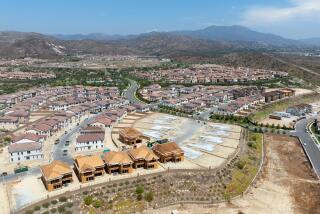NEIGHBORHOOD PROFILE: TURTLE ROCK
- Share via
Population
Population: (1987 est.): 8,934
1980-88 change: +32%
Median Age: 38.6
Racial/ethnic mix: White: (non-Hispanic) 88%
Hispanic: 3%
Black: 1%
Other: 8%
By sex and age: In hundreds
MALES: Median age: 38.8 years
FEMALES: Median age: 38.4 years
Income
Per capita: $33,336
Median Household: $92,888
Average Household: $92,456
Household Distribution:
Less than $25,000 5 %
$50,000-74,999 24 %
$25,000-49,999 14 %
More than $75,000 57 %
Turtle Rock: Paean to Planned Living
Driving east in Irvine along Bonita Canyon Drive, past the Culver Drive junction, the motorist is aware of a high masonry wall that runs without interruption along the left side of the street, shielding what lies on the other side from prying eyes. Barren, burlap-brown hills huddle mutely off to the right and straight ahead, finally stopping the road in a dead end. The rough, ocher surface of the wall is finally punctured by an entrance, and the motorist gains admittance.
Immediately, the senses are assaulted by that shade of emerald-lime-green, peculiar to newly fed lawns and shrubs. Flanking the road to the left are a grassy playing field, clubhouse and tennis courts, part of a community park. Next to the courts, a black, chauffeur-driven limousine waits, and the only sound is the soft thud of tennis balls as they bounce from racket to court surface. To the right, tastefully designed town homes in earthy shades meld with the landscaping. Welcome to Turtle Rock.
Named for a nearby rock formation resembling the shelled reptile, Turtle Rock gives new meaning to the phrase “planned community.” Ground was broken for its first homes in 1967. In the intervening years, 3,299 more have been built. As envisioned by its developer, the Irvine Co., the county’s biggest landowner and community builder, Turtle Rock will eventually support 500 acres of single-family homes, apartments and town houses.
Sixteen parks covering more than 60 acres have been interposed throughout the area’s grounds, creating a cleverly concocted vision of rustic quiescence. Twenty-five miles of paved trails allow cyclists to explore the confines of their walled domain, and more than a dozen playgrounds serve the needs of Turtle Rock’s energetic younger residents. Strict guidelines, regulating everything from housing materials and color schemes to the type of shrubs to be planted, help maintain both a uniformity of building quality and overall residential theme.
This sense of “a place for everything and everything in its place” is a pervasive one, reinforced in both subtle and overt ways as the visitor drives Turtle Rock’s quiet streets. With more than 75 of its roads ending in cul-de-sacs, this is not a place that welcomes aimless Sunday driving. Even the ubiquitous Neighborhood Watch sign goes on the offensive here, with its large, abstract, blue eye and the strident warning: “We immediately report all suspicious activities to our police department.”
Clearly, the precision with which Turtle Rock has been planned and built has not gone unappreciated by the 10,000 people who call the area home. A full roster of professionals--including university professors, lawyers, doctors, financial advisers and former football players--have gravitated here, drawn by a shared vision of family life set in a carefully controlled climate of calm. By the year 1995, 427 more homes, apartments and town houses are scheduled to be built.
More to Read
Sign up for Essential California
The most important California stories and recommendations in your inbox every morning.
You may occasionally receive promotional content from the Los Angeles Times.













